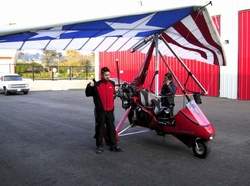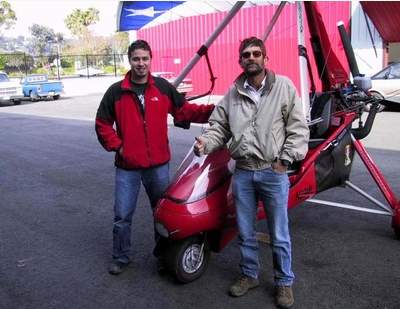by ANN Contributor Jon Thornburgh
One Tough Exam
 On May 6, 2003 trike pilot Matt Liknaitzky passed
his practical test for private pilot-glider. He took the flight
check in an amateur-built experimental Aerotrike Cobra trike at
Torrance (CA). The Aerotrike is registered as an experimental
motorglider.
On May 6, 2003 trike pilot Matt Liknaitzky passed
his practical test for private pilot-glider. He took the flight
check in an amateur-built experimental Aerotrike Cobra trike at
Torrance (CA). The Aerotrike is registered as an experimental
motorglider.
Liknaitzky took all of his training in the trike, and took
the flight check in the trike. His instructor was Jon Thornburgh,
and the pilot examiner was Galen Fisher, from Hemet (CA). Galen is
known for conducting fair but extremely comprehensive flight
checks. Liknaitzky's flight check encompassed two days, May 5th and
6th, and included a hour of flight and ten hours of oral
examination.
The flight check was unusually extensive because Matt was
actually being tested on three aspects of flying: glider
procedures, trike flying, and airplane procedures (since the trike
is a motorglider, it can be flown under power like an
airplane.)
Still Some Restrictions
Liknaitzky's pilot certificate reads "Private Pilot - Glider."
However, Liknaitzky cannot fly a three-axis glider, either a
traditional motorglider or a glider pulled into the air by a tow
plane. The reason is because there is a notation in Liknaitzky's
pilot logbook, which limits him to flying a "weight-shift" (trike)
motorglider only. Matt may qualify to fly a traditional glider by
taking instruction in a three-axis glider and receiving a logbook
endorsement from a glider instructor attesting that he is qualified
to fly a traditional glider. Liknaitzky does not have to take
another FAA practical test to fly a traditional glider.

Right now, Liknaitzky only wants to fly trikes, so he is not
worried about his inability to fly a traditional glider. The
terrific feature about the so-called "Glider-Trike" program is that
a person who is only interested in flying a trike may take all of
his training in a trike, and take his flight check in a trike.
Matt's logged flight instruction time in the trike was 17.5
hours. He is highly proficient in the trike because he has several
hundred hours of trike experience, since he has a microlight
pilot's license from South Africa, his country of origin. He is
also an ultralight trike instructor. However, his microlight and
ultralight flight time does not count as FAA flight time, so his
FAA logbook only showed 17.5 hours of FAA flight experience.
The flight check portion of the practical test began early in
the morning at Torrance Airport, located about 12 miles south of
Los Angeles International Airport (LAX). Torrance is a Class D
airport. The test consisted of various airborne maneuvers,
including a precision "spot" landing, and a simulated
engine-failure on takeoff. Liknaitzky was also required to shutdown
his engine in flight and demonstrate engine-off soaring
procedures.
All of these maneuvers were coordinated with the Torrance
control tower. The tower controllers at Torrance are exceptionally
accommodating to ultralight-type experimental aircraft. There are
several experimental aircraft based at Torrance Airport, including
a Quicksilver, Hornet, Kolb, Kitfox, and Air Creation trike.
One of the benefits of flying an experimental glider-trike is
that the FAA allows an experimental aircraft to fly over "congested
areas." FAA regulations preclude ultralights and microlights from
flying over urban areas, so all of Matt's previous trike flying was
over rural areas only. Matt said it is a unique experience to fly
over houses, high-rise buildings and urban freeways. Because of FAA
regulations, Liknaitzky has previously avoided congested areas even
though he recently flew an ultralight trike from San Diego to
Washington State, accompanied by Barry Palmatier, who is another
FAA licensed glider-trike pilot.

Always Looking For A Place To Land
One aspect of Matt's training was learning how to recognize the
places available for an emergency landing when flying over a city.
Wide roads, golf courses, football fields, dry rivers, parks, and
empty lots are all available landing spots in case of an engine
failure. Matt's flight training consisted of extensive
precision-landing practice so that he could consistently maneuver
the trike to land within a 200-foot distance.

FAA regulations allow aircraft to fly as low as 1000 feet over
congested areas, but Matt and Jon have a self-imposed restriction
to never fly below 3500 feet over the city, in order to allow for a
better opportunity to select a landing spot in case of an engine
failure. The only exception to their 3500-foot rule is in the
traffic pattern at an airport. The traffic pattern for
ultralight-type experimental aircraft at Torrance is 500 foot AGL,
which is 500 feet below general aviation aircraft.
Matt, age 25, was born near Cape Town, South Africa. He now
lives in Santa Monica (CA). He is the North American distributor
for Aerotrike, which is based in South Africa. The Aerotrike
commonly used for training is the "Safari." Matt's experimental
trike, N39ML, is the high-performance "Cobra" touring trike. Matt
added a back-seat hand-throttle and instructor control bars for his
FAA instruction and flight test. The trike is equipped with a 65
h.p. Rotax two-cycle, two-cylinder engine and a Spirit 15 wing. It
is also equipped with a Stratomaster "Ultra" engine digital display
and a Garmin GPS.
 ANN's Daily Aero-Linx (04.16.24)
ANN's Daily Aero-Linx (04.16.24) Aero-News: Quote of the Day (04.16.24)
Aero-News: Quote of the Day (04.16.24) Airborne 04.10.24: SnF24!, A50 Heritage Reveal, HeliCycle!, Montaer MC-01
Airborne 04.10.24: SnF24!, A50 Heritage Reveal, HeliCycle!, Montaer MC-01 Airborne 04.12.24: SnF24!, G100UL Is Here, Holy Micro, Plane Tags
Airborne 04.12.24: SnF24!, G100UL Is Here, Holy Micro, Plane Tags Airborne-Flight Training 04.17.24: Feds Need Controllers, Spirit Delay, Redbird
Airborne-Flight Training 04.17.24: Feds Need Controllers, Spirit Delay, Redbird






